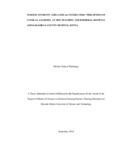NURSING STUDENTS’ AND CLINICAL INSTRUCTORS’ PERCEPTION OF CLINICAL LEARNING AT MOI TEACHING AND REFERRAL HOSPITAL AND KAKAMEGA COUNTY HOSPITAL KENYA
Abstract
One of the criteria for effective learning in nursing education is clinical learning
experience by students. Clinical competence is the ability to effectively integrate
cognitive, affective and psychomotor skills when delivering nursing care. The aim of
this study was to investigate the determinants of clinical learning among Bachelor of
Science in nursing students. The study objectives were; to analyse the influence of
clinical leaning environment on clinical learning, to determine the contribution of
clinical instruction on clinical learning and to examine the influence student factors on
clinical learning. The study employed cross sectional research design. Study targeted
200 participants (165 student nurses, 20 ward managers and 15 clinical instructors)
sampled through purposive sampling. Data was recorded in SPSS version 21.0 and
analysed using t-test for means. A non-para-metric test (Mann-Whitney U-test) was
used to determine differences between students and clinical instructors’/ward
managers. Statistical significance was determined at p=0.01 as the study focused on
perception of the participants. The data was presented in form of tables. Three factors
were found to be the predictors of clinical learning. These were; clinical placement
(p=0.015), practice on patients (p=0.0004) and length of clinical attachment (p=0.04).
Therefore, the study recommends that there is need for hospitals and teaching facilities
to establish appropriate planned schedule with adequate time for clinical learning. The
clinical nurses should be well prepared to assist student and be an example to the
students when they come to the clinical area. Finally, intervention studies involving
larger sample size with wider scope may be needed to establish competency in clinical
learning. The findings will be useful to the higher education institutions and teaching
hospitals in planning and implementation clinical learning of nursing students for
clinical learning improvement through providing an enabling clinical learning
environment, ensuring appropriate clinical instruction and encouraging student factors
that promote clinical

